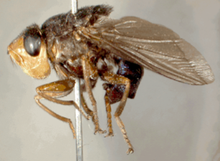Dermatobia hominis
| Dermatobia hominis | |
|---|---|

| |
| Adult female human botfly | |
| Scientific classification | |
| Domain: | Eukaryota |
| Kingdom: | Animalia |
| Phylum: | Arthropoda |
| Class: | Insecta |
| Order: | Diptera |
| Family: | Oestridae |
| Subfamily: | Cuterebrinae |
| Genus: | Dermatobia |
| Species: | D. hominis
|
| Binomial name | |
| Dermatobia hominis (
Linnaeus Jr. in Pallas , 1781) | |
| Synonyms | |
|
Oestrus hominis ( | |
The human botfly, Dermatobia hominis (
Dermatobia fly eggs have been shown to be
This species is native to the Americas from southeastern Mexico (beginning in central Veracruz) to northern Argentina, Chile, and Uruguay,[1] though it is not abundant enough (nor harmful enough) to ever attain true pest status. Normally the greatest risk they pose to humans is increasing the chances of infection. Since the fly larvae can survive the entire eight-week development only if the wound does not become infected, patients rarely experience infections unless they kill the larva without removing it completely.

Remedies
The easiest and most effective way to remove botfly larvae is to apply petroleum jelly over the location, which prevents air from reaching the larva, suffocating it. It can then be removed with tweezers safely after a day. White glue mixed with pyrethrin or other safe insecticides and applied to the spot of swelling on the scalp will kill the larvae within hours, as they must keep an air hole open, so will chew through the dried glue to do this, consuming the insecticide in the process.[citation needed]
Oral use of ivermectin, an antiparasitic avermectin medicine, has proven to be an effective and noninvasive treatment that leads to the spontaneous emigration of the larva.[5] This is especially important for cases where the larva is located in inaccessible places such as inside the inner canthus of the eye.

See also
References
External links
- Case Report: Insect Bite Reveals Botfly Myiasis in an Older Woman
- human bot fly on the UF / IFAS Featured Creatures Web site
- Sampson, Christian E.; Maguire, James; Eriksson, Elof (February 2001). "Botfly Myiasis: Case Report and Brief Review". Annals of Plastic Surgery. 46 (2): 150–2. PMID 11216610.
- Schwartz, Eli; Gur, Hanan (March 2002). "Dermatobia hominis myiasis: an emerging disease among travelers to the Amazon basin of Bolivia". Journal of Travel Medicine. 9 (2): 97–9. PMID 12044278.
- Passos MR, Barreto NA, Varella RQ, Rodrigues GH, Lewis DA (June 2004). "Penile myiasis: a case report". PMID 15169999.
- Denion E, Dalens PH, Couppié P, et al. (October 2004). "External ophthalmomyiasis caused by Dermatobia hominis. A retrospective study of nine cases and a review of the literature". Acta Ophthalmologica Scandinavica. 82 (5): 576–84. PMID 15453857. Archived from the originalon 2012-12-16. Retrieved 2008-10-09.
